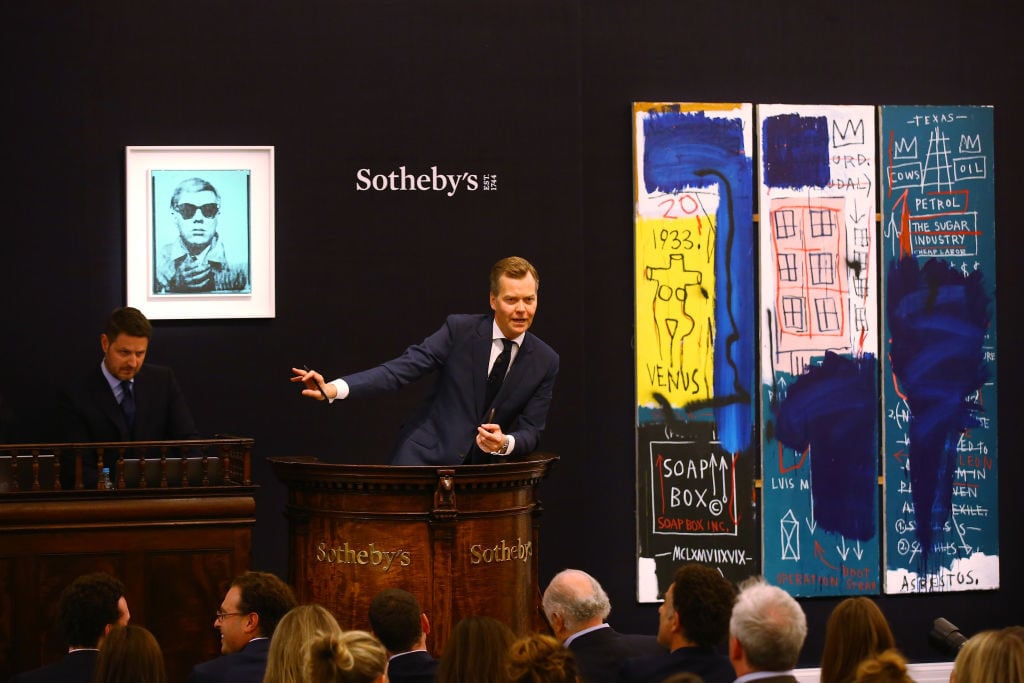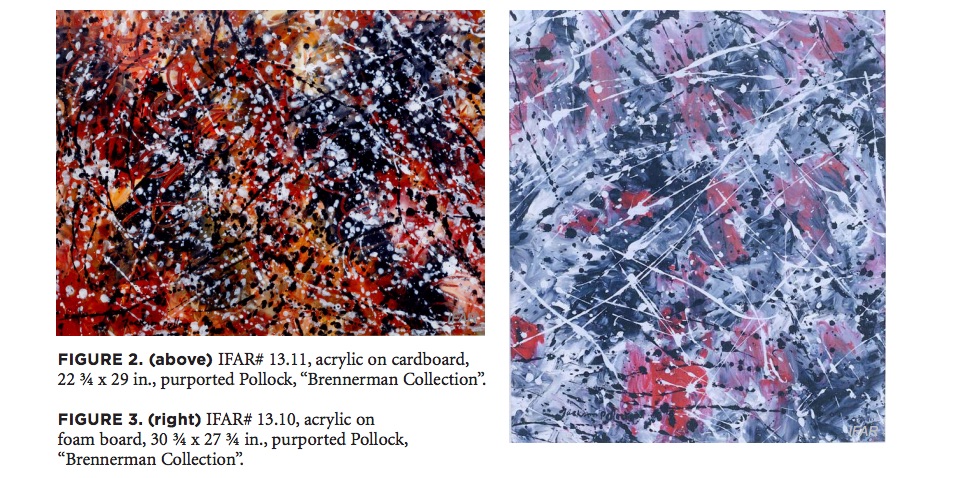Analysis
The Gray Market: Why There’s More to Sotheby’s Premiums Than Meets the Eye (and Other Insights)
This week, our columnist examines three examples of storytelling in the art industry.

This week, our columnist examines three examples of storytelling in the art industry.

Tim Schneider

Every Monday morning, artnet News brings you The Gray Market. The column decodes important stories from the previous week—and offers unparalleled insight into the inner workings of the art industry in the process.
This week, three different forms of narrative-building in our industry of choice…
PRISONER’S DILEMMA: Like a lifelong power lifter suddenly paralyzed on one half of his body, Sotheby’s announced that, effective November 1, it would continue bulking up buyer’s premiums on the analog side of its auctions slate while the buyer’s premiums for the online-only side shrivel to nothing—a move that has deeper strategic roots than the house is stating publicly.
Sotheby’s has repeatedly vocalized its belief that online sales can/should be a significant growth area for the company. Jamming the associated buyer’s premiums into the woodchipper obviously incentivizes further participation on this (not so) new frontier, with the house openly acknowledging its hope that the policy shift will draw in more first-time and early-stage collectors—groups that may not have the confidence or capital to bid in a physical auction.
The contrast between nascent and veteran collectors leads us to the rate hike at Sotheby’s physical auctions. Plenty of others have already noted that this latest upcharge follows almost exactly a year after a previous across-the-board increase (which was preceded by another in February 2015). And the move seems even less surprising given the house’s underwhelming Q2 financials, announced earlier this month.
In the context of Sotheby’s ho-hum revenues, then, pushing premiums higher isn’t exactly as startling as lifting your toilet seat to find a king cobra rising up from the bowl like some hellish jack-in-the-box.
However, the above precedents and justifications don’t explain why Sotheby’s clientele is likely to accept the increase without much more than token complaints. And the strategic rationale only makes more sense vis-à-vis the abolition of the same fees for digital-only auctions.
While online bids have generally risen over the past several years, $1 million still tends to be about the upper limit for most single artworks bought digitally at auction houses. This was true of the seven paintings and sculptures in Sotheby’s 11 top lots sold online in 2016. Even more revealing, all seven of those works were won by online bids submitted to physical sales, meaning that nothing in a strictly digital auction hammered for higher than even $582,000 after fees.
But this trend doesn’t just owe to hesitance or demographics on the buyers’ side. Remember, Sotheby’s and its competitors ultimately control which lots go into which of their auctions. (Collectors can make demands about placement, but it remains the houses’ prerogative as to whether those demands are worth acceding to.) Part of the reason we’re not seeing higher online-only auction results is that the houses are putting consistently higher quality—and thus, higher estimate—lots in analog sales rather than digital ones.
This makes bidders at its physical auctions something of a captive audience. If they want a chance to acquire the (allegedly) best stuff, they have to opt into the live experience and the higher fees it now entails.
Their only other choice is to abstain, meaning to voluntarily forgo a huge chunk of the most appealing offerings in the auction sector. And if Christie’s raises its own rates in response, as it seems to have done last time, then there’s even less incentive to say no to Sotheby’s.
This isn’t the only justification for the venue-based divergence between the house’s buyer’s premiums. Sotheby’s also has to spend a lot more to produce a physical sale than it does an online-only sale.
So a small proportion of digital bidders in otherwise-analog auctions won’t save the company enough to pass back via lower rates. Which helps explain a paradoxical detail of the premium hike: Online bidders participating in physical auctions will still be charged the same (higher) premiums as their competitors on the phones and in the flesh.
While there’s legitimacy to Sotheby’s public statements about the annihilation of buyer’s premiums for digital-only auctions, then, I’m confident there’s also more to the story. And as usual, the dollars are in the details. [ARTnews]

Leah Dickerman (photo: Martin Seck) and Rob Baker (photo: Martin Sekera). Images courtesy of MoMA.
INFINITE CONTENT: On Thursday, New York’s Museum of Modern Art (MoMA) signaled a serious commitment to advancing its program in forward-looking, tech-savvy, and social-media-conscious ways with one new hire and one major role change for a highly respected staffer.
The museum tapped Rob Baker, ex-chief marketing officer of Tate, to be its director of marketing and creative strategy. More unexpectedly, MoMA will team Baker with soon-to-be former curator of paintings and sculpture Leah Dickerman, who will shape-shift into the institution’s first director of editorial and content strategy. Both Baker and Dickerman will take up residence in their new posts starting this October.
For anyone asking, “What the hell do those titles mean?” MoMA’s statement may or may not clarify. The museum announced that Dickerman and Baker would usher in a “transformation of its approach to storytelling and marketing that will use both traditional and new media in innovative ways to showcase great art and artists, reach new audiences, and deepen engagement.”
All of which, I can tell you with the conviction of multiple years as a ghostwriter, is the same kind of language ad-agency execs and commercial directors use to discuss online branded content for everything from Big Macs to Tampax. And that’s exactly why, if you listen closely, you can already hear a phalanx of art critics of a certain age furiously typing aggrieved posts about the blasphemy of a major museum having any “creative strategy” or “content strategy” other than a scholarship-driven exhibition program.
However, what I learned through those painful experiences covertly shilling for conglomerates is that, in the land of branded content, it’s the people, the brand, and the product that separates trailblazing from gas-bagging. If you have winners on those three fronts, then it is possible to produce analog and digital content that at least makes a substantive message more memorable, if not enriches and expands the way audience members absorb it.
MoMA appears to have that trifecta in hand. For evidence, my colleague Julia Halperin pointed to some of the “traditional and new media” content created in conjunction with two recent exhibitions curated by Dickerman: “Robert Rauschenberg: Among Friends,” which birthed a three-part video series on the installation of show highlight Mud Muse; and “One Way Ticket: Jacob Lawrence’s Migration Series and Other Visions of the Great Movement North,” which triggered “a children’s book, newly commissioned poetry, and a flashy data visualization on population changes during the Great Migration.”
To me, these all qualify as legitimate ways for MoMA to boost accessibility without dumbing down great artwork. They also prove that not all branded content or visual storytelling needs to be as embarrassing as, say, a transmedia campaign anthropomorphizing toenail fungus medication as an animated superhero.
By pairing a renowned curator with a museum marketing veteran, then, MoMA looks poised to launch an ongoing audience-outreach campaign that is more flexible, broader, and meatier than its institutional competitors. I applaud them for thinking differently, and I hope that I’m not alone. Because, after all, how many more evening concert series, film screenings, and live talks can the museum sector hold? [artnet News]

Courtesy of IFAR.
POLLOCKS VS. BOLLOCKS: Finally this week, a particularly batshit Jackson Pollock forgery scam spoke volumes about what the wider world thinks of the art world. But it should also chasten industry insiders about their own level of savvy and susceptibility to art-market snow jobs.
The International Foundation for Art Research (IFAR) confirmed that, starting in 2013, three different collectors brought four alleged Pollock works their way for authentication. All were deemed fakes, and all had a provenance that included the collection of one James Brennerman. According to Laura Gilbert and Bill Glass of The Art Newspaper, nearly everything about this figure was extraordinary:
The buyers were told Brennerman was a German immigrant who settled in Chicago in the 1940s. Around 1968, he and an art collector friend named Charles Farmer paid cash for 748 Pollocks, “two truckloads” of art. The seller was said to be Pollock’s widow, Lee Krasner. In 1970, Brennerman purchased Farmer’s share. As described through decades of correspondence—all oddly written by Brennerman, “often in poorly-written German,” the IFAR Journal notes, but none written to him—the collector eventually went mad, saying he would be “transported to another planet over which I will rule. I am destined to become a god.”
It turns out, however, that Brennerman, his “Pollocks,” and pretty much every element of the narrative behind them is as genuine as a vow of love from a mail-order bride. Gilbert and Glass again:
As was the case with Brennerman, IFAR was unable to find any reliable official record of Farmer or the Ramseys. The dossier also included photographs that are meant to show Brennerman’s estate but are actually of the Sforza Castle in Milan, the Neptune statue in Madrid, and an 18th-century Bavarian church.
Oops.
Aside from its vibrant colors, the scam is noteworthy for its targeting of collectors outside the usual art-industry hubs. Of the “less than two dozen” Brennerman-associated Pollocks IFAR has identified in the succeeding four years, the organization relays that all seem to have been sold to “a whole network of people who are not professional dealers, a different world from what we’re used to.”
Most of these buyers lived outside American arts capitals, and almost all paid prices in the five figures. Which would make each sale the most extraordinary bargain for Pollock’s work since Peggy Guggenheim put the artist under contract (circa 1945) for what would be about $3,000 a month today.
And yet, as tempting as it might be for members of the art establishment to paint these buyers as gullible yokels who should have known better, the Brennerman narrative is only a few fractions of an inch ballsier than a narrative that suckered multiple high-level collectors in New York and other industry hubs for decades.
In the infamous Knoedler forgery case, a whole host of New York insiders got torched by Glafira Rosales and her mysterious Swiss mega-collector “Mr. X”…who, it turns out, was actually a middle-aged Chinese immigrant painting skillful fakes out of a Queens garage.
No one but Rosales ever saw Mr. X, of course. The details of his life and collection kept changing, too. And yet high-end collectors still spent a grand total of over $60 million on roughly 40 alleged Ab Ex “masterpieces” over the span of approximately 20 years.
Why? Because people inside and outside the industry still generally expect the art world to be a shit show performed by eccentrics, amateurs, and straight-up lunatics. So whether you’re going to peddle fake Pollocks in Colorado or phony Rothkos in New York, why be conservative about the storytelling? And while that dynamic might make for entertaining stories, it raises a lot of questions about the way business is done in the art trade in 2017. [The Art Newspaper]
That’s all for this edition. ‘Til next time, remember: Narratives are stronger than facts.